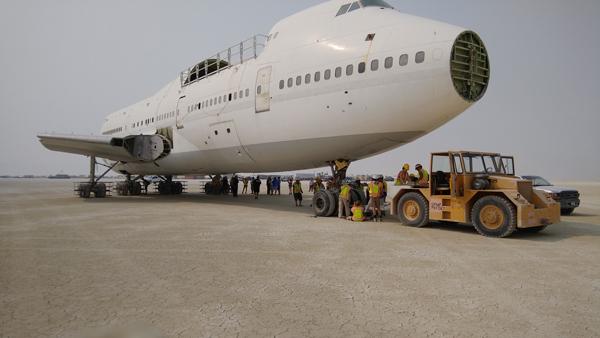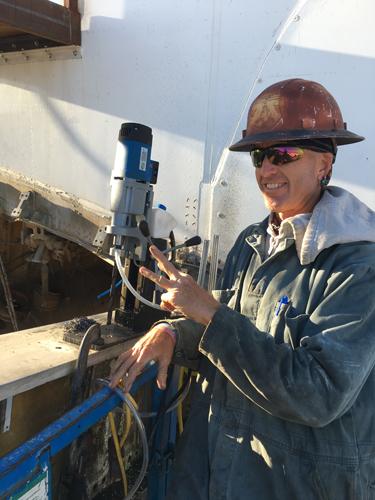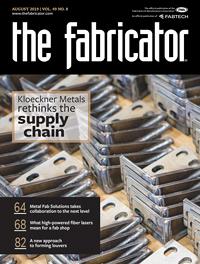- FMA
- The Fabricator
- FABTECH
- Canadian Metalworking
Categories
- Additive Manufacturing
- Aluminum Welding
- Arc Welding
- Assembly and Joining
- Automation and Robotics
- Bending and Forming
- Consumables
- Cutting and Weld Prep
- Electric Vehicles
- En Español
- Finishing
- Hydroforming
- Laser Cutting
- Laser Welding
- Machining
- Manufacturing Software
- Materials Handling
- Metals/Materials
- Oxyfuel Cutting
- Plasma Cutting
- Power Tools
- Punching and Other Holemaking
- Roll Forming
- Safety
- Sawing
- Shearing
- Shop Management
- Testing and Measuring
- Tube and Pipe Fabrication
- Tube and Pipe Production
- Waterjet Cutting
Industry Directory
Webcasts
Podcasts
FAB 40
Advertise
Subscribe
Account Login
Search
Transporting a decommissioned Boeing 747 jumbo jet 500 miles to Burning Man
Reassembling a disassembled 747 required ingenuity to drill through titanium wing spars
- By Sue Roberts
- Updated August 30, 2023
- August 14, 2019
- Article
- Finishing

Big Imagination’s Boeing 747 is shown partially disassembled. A magnetic drill was able to drill through titanium wing spars of a jumbo jet without too much trouble, guaranteeing the party went on as scheduled at Burning Man 2018. Photos provided
It takes a flight of fancy to come up with an art project that begins with transporting a 1985 Boeing 747-300 from the Mojave Air and Space Port boneyard to the Black Rock Desert of Nevada along 500 miles of public highways.
Ken Feldman, CEO of Big Imagination, imagined repurposing the aircraft to create an interactive space where people can dance, enjoy music, and leave their day-to-day lives behind without actually taking off. (The Big Imagination Foundation is a 501(c)3 nonprofit organization. In its own words: “We incubate bold, visionary projects that inspire the world to dream big.”) Feldman put his faith in a small crew and a cadre of more than 500 volunteers to achieve the dream over a three-year period that culminated with the plane’s debut at Burning Man 2018, an arts and music festival held in northwest Nevada every fall. Most of the work in transforming the jet was accomplished during long weekends.
With highway travel lanes typically between 9 and 12 feet wide, according to the Federal Highway Administration, moving the plane to the site for its reinvention meant breaking it down into much smaller sections that could be put back together once they arrived at their new home.
Removing the tail and large portions of the wings brought the size of the plane down to 135 ft. long, 32 ft. tall, and 60 ft. wide. It was still too large to move on highways. Further disassembly included cutting the aerospace-grade titanium alloy backbones of the wings and landing gear in half with a plan to reassemble using 7000 series aluminum splice plates.
Drilling volunteer Keru McKenzie, part of the team dubbed the 747 Mechanic Group, said that the engineering plan for further dismantling called for removing the top half of the fuselage and the wings basically by cutting the plane’s ribs, skin, and stringers. The wing spar material was the problem.
“The titanium wing spar beams were the big bugaboo of the project. They were so big and hard to work with that we didn’t really know how we were going to do it right up to the month we were going to work on it. The root of the beams goes back into several hundred bolts and assemblies, so we couldn’t unbolt them without taking the entire plane apart,” McKenzie said.
“We knew we could go in there with tools like grinders and abrasive saws to cut the beams, but we needed to be able to put them back together and maintain their structural integrity. We needed to put splice plates with holes across the cuts so they could be bolted back together. What we didn’t know was how to drill the 5/8-in. holes in the 2-in.-thick aerospace-grade titanium alloy.”
Titanium Troubles
Titanium, with its high strength-to-weight ratio, drills differently than steel or aluminum in some important ways. Angular hole cutters that work well in steel and aluminum have problems clearing titanium chips and providing enough coolant flow. When cutting 1- to 2-in. holes, work hardening is likely and restarts after the cutter is lifted to remove chips are difficult to impossible.
“If you’re going to drill steel and you have a mag drill, you can put a cutter on the material and you’re set. The drill bites into the steel and turns out a lovely birdnest of chips. Aluminum is a little gummier than steel but cuts good up to about a 1-in. depth,” McKenzie said.
“But titanium is especially tough stuff. It probably takes double the force needed to drill steel, and the chips don’t like to come out in nice little strings. And it likes to work-harden so if the drill is scraping and not actively cutting, the titanium will heat up, get stronger, and burn up the tips on the drill. Titanium dissipates heat fairly slowly, and since it heats up so fast you need a lot of coolant during cutting.

The Boeing 747 was cut down to size for transport—along public highways—to its transformation location in Nevada’s Black Rock Desert.
“Then, once you get down more than ½ in., even if you have a sharp annular cutter, it won’t readily feed out chips.”
The drilling problem was identified during test cutting of titanium samples before attempting the holes in the beams themselves. This prompted a search for equipment and tooling that would make the chore of drilling the 232 holes in the titanium beams possible.
Although titanium was the most difficult material of the project, other metals were involved. McKenzie drew on his experience as a fabricator to develop a process to drill the holes once the cut points were determined but before the cuts were made.
“We put aluminum plates around the beams to make them strong enough to be put back together with structural integrity. To get the strength back up to nearly flight strength after reassembly, we put 2 in. of aluminum plating on top and 1 in. below on each of the beam’s two flanges, as well as two 1-in. plates on the side of the beam. That meant we had to drill through nearly 5 in. of material at once to be sure the bolts would line up. We wanted to match drill those holes,” said McKenzie.
Equipment, Tooling, and Creativity
Finding a drill and tooling that could handle the job took some trial and error. A hand-held drill and a magnetic drill failed to make it through the multiple levels of varying materials.
While the team was searching the internet for other possibilities, the large MAB 485 portable magnetic drill from CS Unitec caught their attention.
McKenzie said, “We saw the big magnetic drill with a long enough vertical stroke to allow us to match drill the 5-in. stack of material. It has a 2-speed drive so we could drill using low speeds and high torque. Its Morse taper fit drill chucks, and we also had the option of using a regular machine tool with it. We bought a 9-in. tool body that had through-body cooling and replaceable carbide tips. One toolholder was used for the entire operation with 2x carbide inserts changed every 10 holes.”
The drill’s automatic internal lubrication system with an external lubrication system option was a welcome feature; however, McKenzie designed an additional large-capacity, gravity-fed system to ensure a constant feed of coolant to the cutting site regardless of drill orientation. Each of the two wing spars needed 40 upright, 40 inverted, and 36 horizonal holes.
A constant flush of ProLube™ nontoxic cutting lubricant controlled the friction and heat generated while drilling the titanium, protecting against material hardening and helping to extend the life of the tooling.
McKenzie came up with a workaround for positioning the magnetic drill on nonferrous material. Sections of ½-in. steel plate, about 6 in. by 20 in., were clamped on to the titanium beam to create a ferrous base that would work with the drill’s magnets. He said that drilling pressure was between 90 and 99 percent of magnet liftoff force, and between 20 and 30 pounds of pressure were required to keep the tool cutting. The steel plates also acted as a template for properly placing the holes.
“We used the predrilled holes in the steel plates to direct where we drilled the holes in the ribs. That sped up the work quite a bit. Still, drilling the 232 holes in the titanium took about two solid weeks of drilling. We had some very good jigs set up so it was mostly a matter of moving the drill to the right spot and pulling on the handle for about 10 minutes per hole,” McKenzie said.
Ready to Party
Today the reassembled and reimagined 747 is parked in a storage area in Nevada where the work is basically completed but things are occasionally fine-tuned, McKenzie said.
“We can add more railings or make more dance floors … there is a lot of space in a 747,” he added.
This fall’s Burning Man festival in Black Rock City, Nev., may be the perfect place to reintroduce the huge, rolling art project. There, the 747’s interactive space will be opened to party-goers as part of the event’s goal to make participants of everyone. Like the imagination that gave a grounded plane a new design and purpose, the nine-day gathering draws thousands of people together to celebrate new ideas, fresh beginnings, artistic self-expression, and life with a new twist.
About the Author

Related Companies
subscribe now

The Fabricator is North America's leading magazine for the metal forming and fabricating industry. The magazine delivers the news, technical articles, and case histories that enable fabricators to do their jobs more efficiently. The Fabricator has served the industry since 1970.
start your free subscription- Stay connected from anywhere

Easily access valuable industry resources now with full access to the digital edition of The Fabricator.

Easily access valuable industry resources now with full access to the digital edition of The Welder.

Easily access valuable industry resources now with full access to the digital edition of The Tube and Pipe Journal.
- Podcasting
- Podcast:
- The Fabricator Podcast
- Published:
- 04/16/2024
- Running Time:
- 63:29
In this episode of The Fabricator Podcast, Caleb Chamberlain, co-founder and CEO of OSH Cut, discusses his company’s...
- Industry Events
16th Annual Safety Conference
- April 30 - May 1, 2024
- Elgin,
Pipe and Tube Conference
- May 21 - 22, 2024
- Omaha, NE
World-Class Roll Forming Workshop
- June 5 - 6, 2024
- Louisville, KY
Advanced Laser Application Workshop
- June 25 - 27, 2024
- Novi, MI

































